
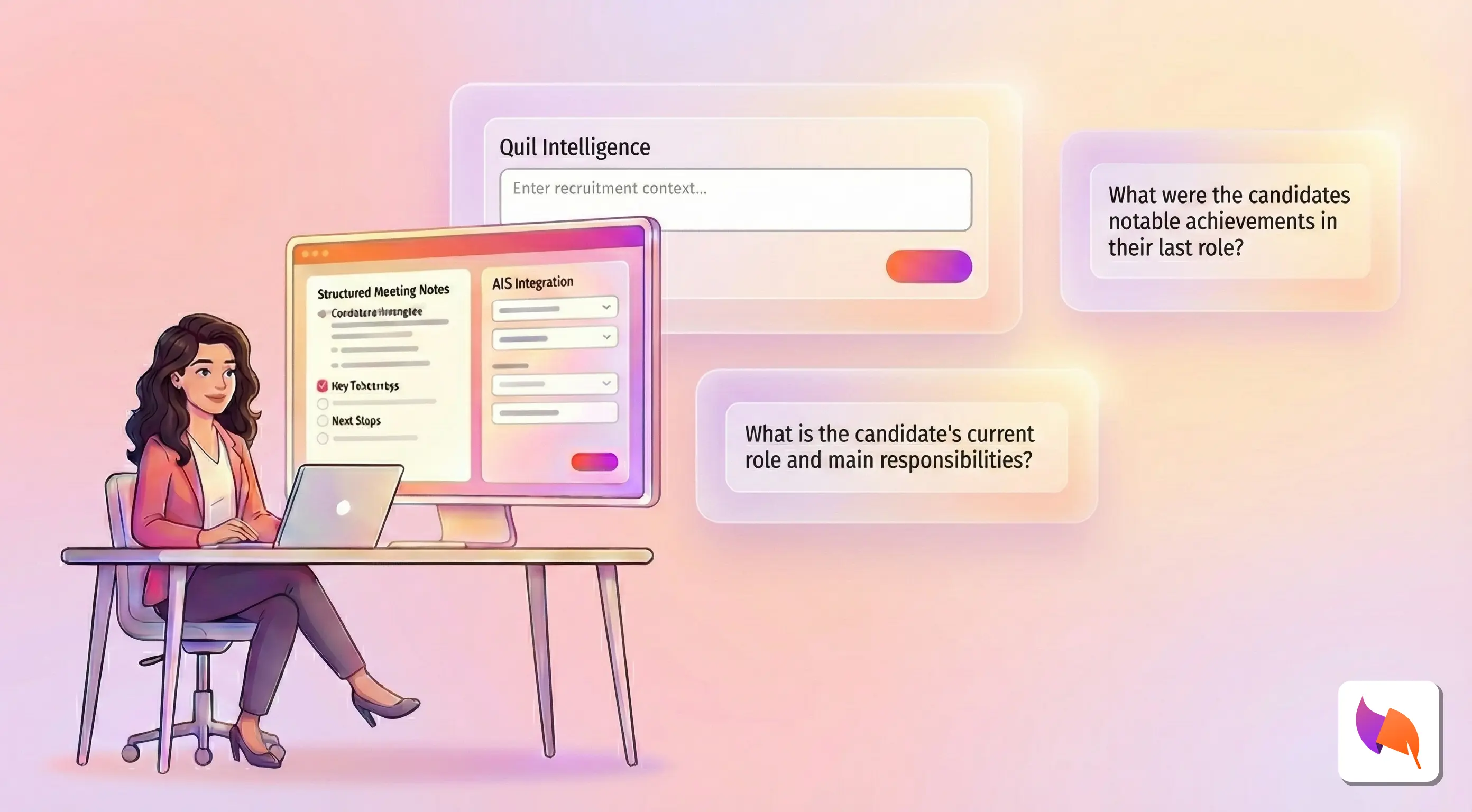
AI prompting is where the magic happens inside Quil. It’s essentially teaching the software to think like you: what kind of questions you ask, how you structure notes, and follow-up materials you need from different calls. Ultimately, AI prompts make Quil smarter at generating meeting notes, client follow-up materials, and ATS-ready candidate fields.
Prompting isn’t about “knowing AI.” It’s about translating your recruiting instincts – the questions you already ask candidates every day – into clear instructions the AI can follow. In Part 1 of our Prompting in Quil series, we’ll walk through AI prompting basics. By the end, you’ll be able to create your own AI prompts within Quil that will help you generate consistent, high-quality outputs from every call.
Before we get into writing great prompts, it helps to understand what prompting actually does inside Quil.
When you enter a prompt, you’re essentially training Quil on how to listen, capture, and summarize your recruiting conversations. Think of prompts as a set of instructions that shape how Quil interprets candidate responses, job details, and key takeaways.
A clear AI prompt provides Quil with three things:

At the heart of Quil’s prompting system are a few simple but powerful rules. These rules help the AI understand who is speaking, what to capture, and how to organize the information correctly for any type of call: client intake, candidate interview, or reference check, for example.
Below are four key rules that will set you up for success when writing AI prompts in Quil.
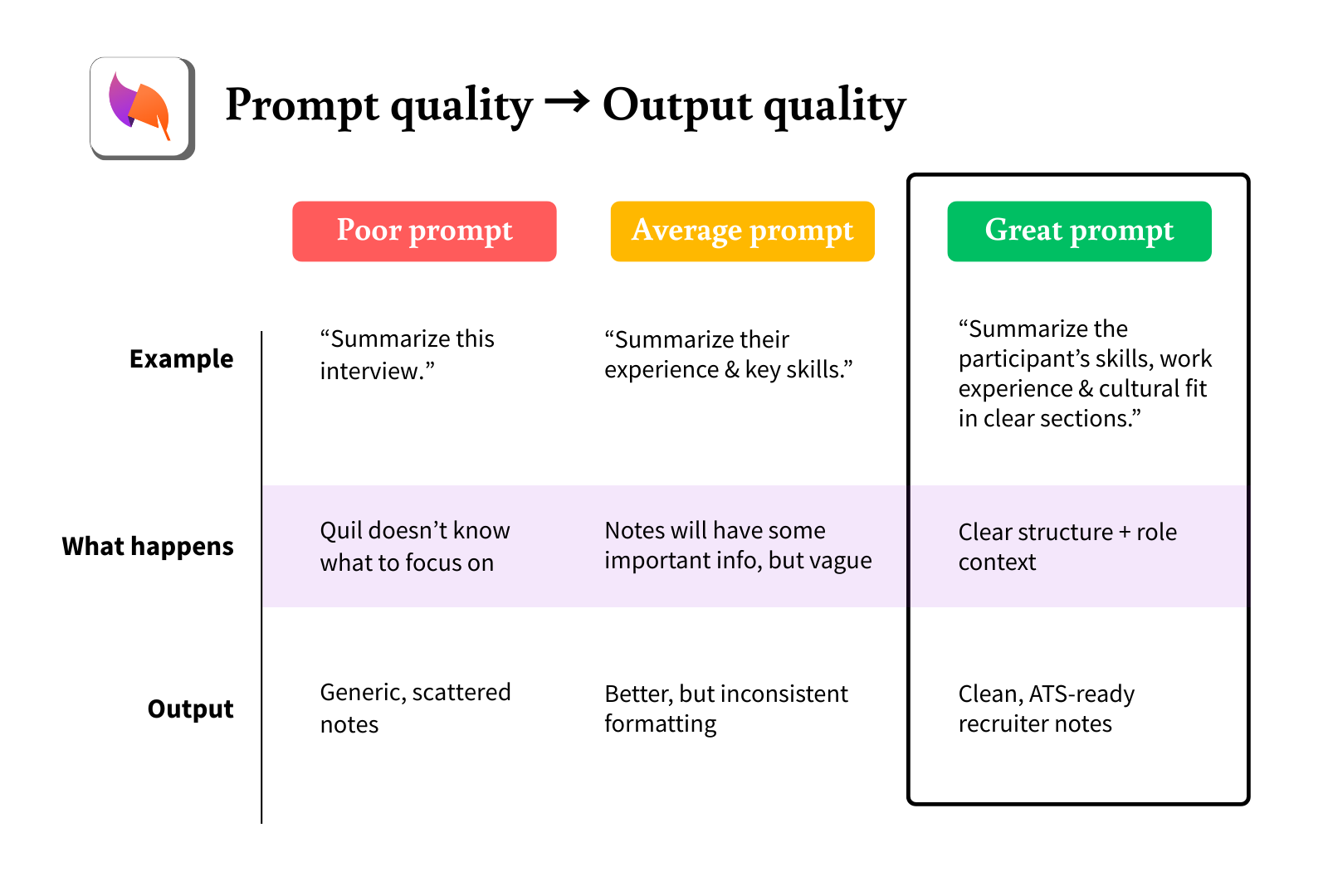
On any call, Quil recognizes two distinct speaker “roles:”
If you have more than two speakers on a call, define each role clearly so Quil knows who’s who. For example, in a client intake or panel interview, you might specify: “Host” (the recruiter), “Client” (the hiring manager), and “Participant” (the candidate).
Then, refer to them by role in your prompts. For instance, “Summarize the participant’s responses to the client’s questions.” This keeps Quil from mixing up who said what.
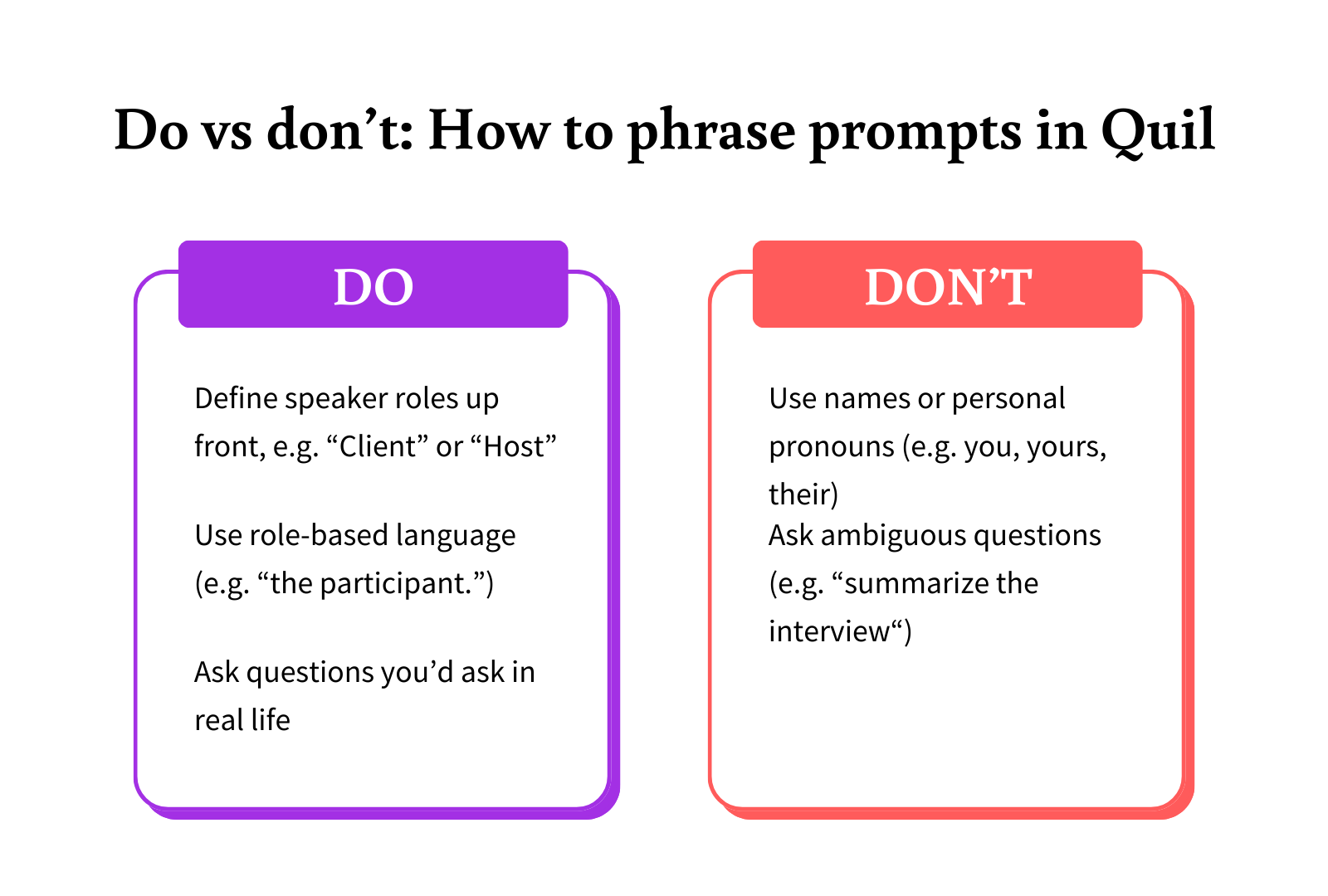
When writing AI prompts, avoid personal pronouns like you or your when referring to the participant – these pronouns confuse the AI into thinking the question applies to the host. Instead, always refer to the other person on the call as “the participant.”
The best prompts are a reflection of how you talk to candidates, just adapted slightly for Quil.
For example, if you’d normally say, “Walk me through your last role. What did you enjoy most?” you can write it as:
“What is the participant’s most recent role and what did they enjoy most about it?”
This keeps your tone conversational but still gives Quil clear, unambiguous instructions.
Meeting notes are designed to summarize key points from your conversations in a structured, scannable format. To make this work in Quil, you first create note categories inside each Meeting Type.
For example, Work Experience, Motivations, or Compensation. These categories usually align with sections in your ATS or internal workflow. Once your categories are set, you then write prompts under each category, guiding Quil on what details to capture.
The best-performing prompts use headers followed by direct questions. Ideally, they should be structured as follows:
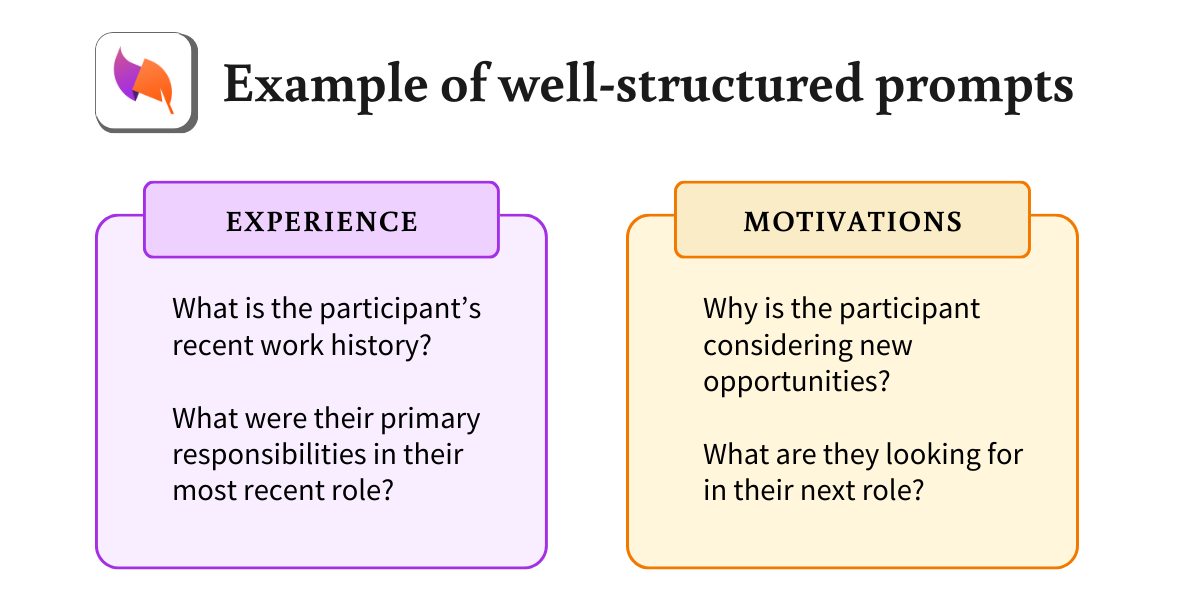
What is the participant’s recent work history and most recent role?
What were their primary responsibilities and notable achievements?
Why is the participant considering new opportunities?
What are they ideally looking for in their next role?
This format makes it easy for Quil to understand exactly what information belongs where. When these notes sync to your ATS, each detail lands in the right field — no manual editing needed.
Specific prompts help Quil capture consistent details for topics that you’ll always cover in a certain call, like Work Experience or Compensation in a candidate interview.
For example, a specific prompt might be, “What is the participant’s recent work history and most recent role?”
Broad prompts, on the other hand, give Quil flexibility to capture unexpected – yet relevant! – information that might not fit neatly into a defined category.
A broad prompt might be something like, “Include any additional relevant information that helps complete the candidate’s profile.”
Why is it important to include a mix of vague and specific prompts? Well, if your prompts are too specific, Quil’s notes can feel rigid and miss context. But if they’re too vague, the notes may lack a clear and cohesive structure or key details about the meeting.
This combination ensures you get structured, recruiter-ready notes — without missing important context that comes up naturally in conversation.
With your prompts, Quil will capture what you ask for. So, if a section contains specific questions, it won’t pull unrelated details. Instead, your prompts should be intentionally structured to get the answer you want quickly and concisely, without being buried in extraneous information.
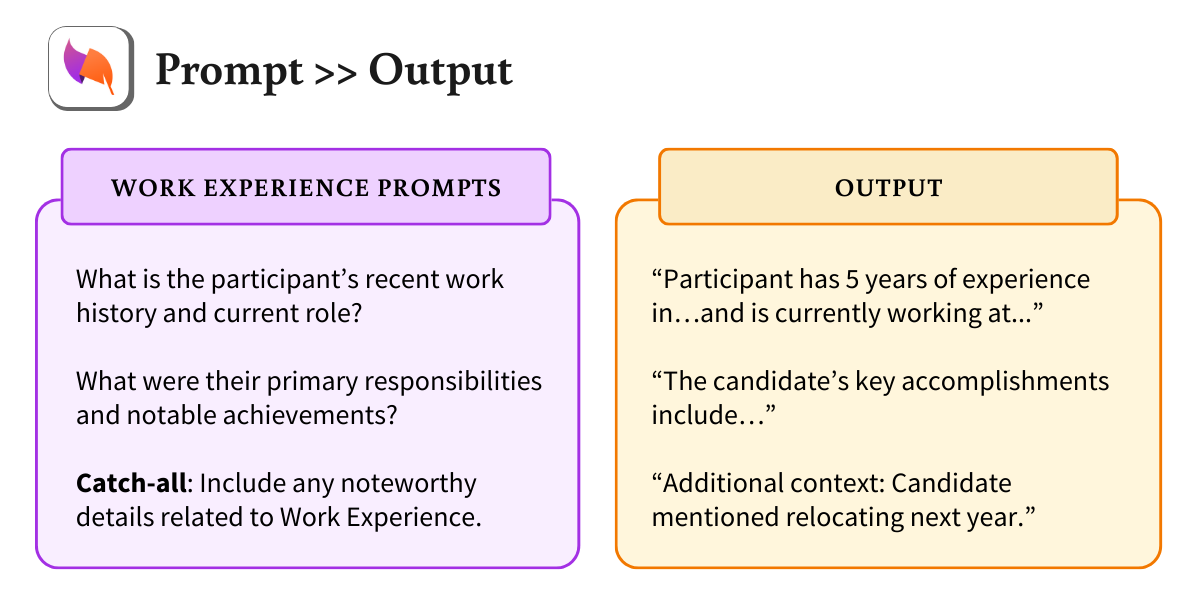
If you’re not sure whether your prompts will capture all the details you want, you can use a catch-all. For example, use a broader prompt like “Include any noteworthy details the participant mentioned related to Work Experience.”
Once you’ve built prompts that reflect your workflow, tone, and priorities, you’ve essentially trained a digital version of yourself.
The setup does take a bit of upfront effort, but that effort compounds. Once you’ve created your prompts, every recruiter on your team benefits from consistent, structured, and on-brand notes.
What does that look like? Well, here’s the beauty of a well-prompted workflow:
A Quil prompt is a set of written instructions that tells the AI how to interpret and summarize your recruiting conversations. It provides context, structure, and intent—so Quil knows what kind of call it’s analyzing, what details matter most, and how to organize your notes for your ATS.
To write effective AI prompts in Quil, use clear language that mirrors how you speak with candidates. Start each section with a header (like Work Experience or Motivations), followed by direct questions beginning with what, why, where, or how.
Example:
Customizing your Quil prompts helps the AI think and write like you do. When prompts reflect your tone, priorities, and workflow, you get consistent, recruiter-ready notes—and less time spent editing or reformatting later.
Yes. By refining your prompts, you’re essentially training Quil to replicate your team’s interviewing and note-taking style. Once the setup is done, every recruiter benefits from consistent formatting, cleaner data, and faster notes.